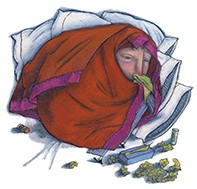Peer Reviewed
Feature Article Infectious diseases
Using neuraminidase inhibitors against influenza
Abstract
Two drugs specific for the treatment of influenza virus infection have recently become available in Australia. They are effective against all known epidemic strains and there is no indication of clinically relevant drug resistance. However, the therapeutic benefits are dependent on accurate diagnosis and early treatment.
Key Points
- Use the neuraminidase inhibitors only in patients who satisfy all of the following criteria: have a compatible clinical illness; present within 48 hours of onset of illness; and are in an area where there is local influenza activity or have returned from an area of influenza activity within the previous few days
- Treatment should be started as early as possible. The earlier patients are treated and the sicker they are, the greater the benefit they will get.
- Treatment should be considered for all patients suspected of having influenza, but especially those at high risk of serious influenza infection (by the NHMRC definition). These patients have the greatest potential benefit from treatment, with a likely reduction of the acute illness and prevention of complications.
- Other patients may also elect to use neuraminidase inhibitors depending on how ill they are, how early they are being treated, and their social or financial need to reduce the severity of influenza infection.
- Treatment may also be considered when there is a significant risk of spread to susceptible high risk contacts, such as nursing home residents.
Purchase the PDF version of this article
Already a subscriber? Login here.

